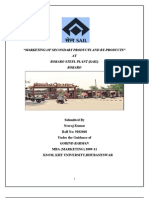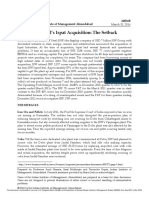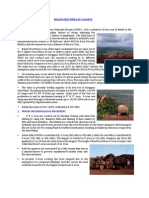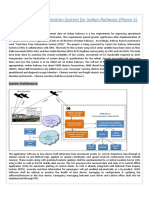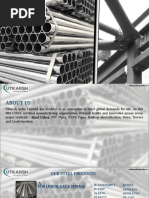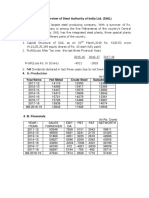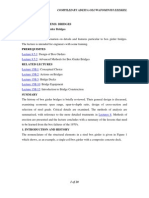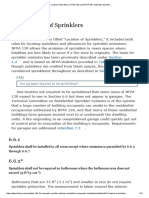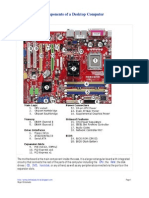How To Secure Steel Coils
How To Secure Steel Coils
Uploaded by
Mauricio Gomes de BarrosCopyright:
Available Formats
How To Secure Steel Coils
How To Secure Steel Coils
Uploaded by
Mauricio Gomes de BarrosOriginal Description:
Original Title
Copyright
Available Formats
Share this document
Did you find this document useful?
Is this content inappropriate?
Copyright:
Available Formats
How To Secure Steel Coils
How To Secure Steel Coils
Uploaded by
Mauricio Gomes de BarrosCopyright:
Available Formats
Hapag-Lloyd AG
23rd January 2008
How to secure steel coils in 20gp container
General
Following points to be observed for securing coils:
- correct length of the cradle for weight distribution
- blocking against side and length shifting in floor height above the bedding
- lashing in four direction or several coils together to one full block
The below securing guideline is valid for all types of coils. Coils can be loaded eye to the
sky, eye to the door or eye to the side. Usually loading coils eye to the sky is not so
problematic, as the coil weight is not so high and the weight is better distributed. Loading
eye to the side is the common method and usually used for the heavy coils. Therefore
the first chapter explain stuffing coils eye to the side. All guidelines like weight
distribution, bedding, blocking and lashing have to be followed by all stuffing methods
(eye to sky and eye to door). At the end some special chapters added for loading coils
eye to the door.
Part A coil stowed with eye to the side
1. Preparation of cradle
Build a cradle which meets
the following requirements:
Length (a) in cm to be
calculated: coil weight in kg
/ 48 kg/cm. (Limit: 4,8t per
meter = 48kg per cm) or
longer.
Maximum free end b on
each side depends on the
c
thickness of used square
timber.
b
a
10x10cm: max 50cm.
15x15cm: max 75cm.
20x20cm: max 100cm
25x25cm: max 125cm.
30x30cm: max 150cm.
If hard wood is used above
value can be extended by 10cm. Hapag-Lloyd do not recommend the use of timber with
25x25cm or higher and also hard wood because of environmental reasons.
If not possible to meet these requirements, coils are too heavy for loading on timber
bedding. Then steel bedding or other container types like flatracks required. Pls contact
first your sales office, when you intend to ship heavier coils.
In summery of above requirement, coils of more than 15t can not be shipped in 20
standard container. If somebody insists to ship heavier coils, stuffing method has to be
agreed with special cargo department of Hapag-Lloyd case by case.
The coils have always to be place in the container with the bedding in length direction.
The bedding needs to have minimum 2 timbers in one-piece, placed as fare as possible
Page 1 of 5
How to secure steel coils.doc
Hapag-Lloyd AG
23rd January 2008
to the outward position, close to the container side walls. Additional beddings below the
middle of the coils are not a requirement from the container owner, but can be added.
Example1: coil weight: 7650kg, c=65cm Result: a=160cm, b= (160-65cm)/2=48cm
square .timber 160x10x10cm possible.
Example2: coil weight: 9960kg, c=75cm Result: a=208cm, b= (208-75cm)/2=67cm
square .timber 210x15x15cm possible.
2. Position inside the container
A single coil should be placed in the middle in length and athwart direction inside the
container. When two coils are loaded in the container, it should be avoided to place both
together in the middle. Place one as far as possible to the end wall and the other as
close as possible to the door side. The space to door and end wall required for blocking
and securing shall of course remain.
3. Blocking
Task of the blocking is to prevent sliding of coils in length and athwart direction. It needs
to be taken in account, that the door can not take any force and the container walls are
very soft. Thus the blocking is to be spread over a large surface and in the lowest
possible height.
Blocking to the side: Timber
(a) already there from the
cradle, see chapter 2. Then
two pieces (b) to be placed
between (c) and (a), with a
distance in between as wide
as possible. To keep all
pieces (b) and (c) in the
same height, min. 4 pieces
supports (d) to be placed
below and nailed together. It
is important that (b) do not
touch the containers side
wall.
Side view:
c
b
a
b
c
b
d
Same patter to be done on the other side.
Blocking in length direction to be placed against athwart timber (e) on which the coil rest.
Page 2 of 5
How to secure steel coils.doc
Hapag-Lloyd AG
23rd January 2008
f
g
Both pieces (f) need to be placed between (e) and (g), all in the same height. Best to lay
pieces (f) on the bedding and put the timber (g) on top of supports (h) with the same
height as the bedding. Square timber (g) to be set with its ends into the corrugated side
walls of the container.
Blocking between 2 coils simple to be done with two pieces (f) between (e) of each coil.
Blocking to end wall of the container can be done with (g) fixed into the corrugated side
walls or touching the end wall over the full width, same pattern as blocking to the side (c).
There are special requirements for rail shipment. A stronger blocking in length direction
is required by the rail companies. To place a timber (g) in between the corrugated
sidewalls is not accepted. Therefore the blocking is to be set against the corner posts
and end wall of the container and into the recess of the corner post at the door side.
Top view at container door:
Container wall
Strong timber
Thin timber fits into the
recess.
Recess at corner post
f
g
Door
Picture left side shows example of blocking lengthwise with
use of the recess in corner post at door side.
Finally we can say that blocking is possible without nailing to
the container floor and any wedges. Nails can be used to keep
the wood constructions together, but no forces should be
brought to the nails. Also the wedges can be used as bedding
of the coil, but not for blocking.
Page 3 of 5
How to secure steel coils.doc
Hapag-Lloyd AG
23rd January 2008
4. Lashing
Aim of the lashing is to secure against tipping. The height on which the lashing is fixed to
the coil is usually below the middle. Therefore it is only workable when the coils are
blocked in floor height as well. The lashing of each coil needs to be done by 4 lashings.
Each starts and ends on the same point. As lashing material can be used best steel
straps, but also nylon belts with edge protections or steel wires.
Top view
Front view
As the lashing eyes of a container can take only 1-2t, the strength of lashing material
need not more than 2t.
5. Example
Here you can see one
picture of good securing a
steel coil with eye to the
side.
For heavy, high and thin steel coils it is
useful to add a blocking to the side wall in
a higher position.
Page 4 of 5
How to secure steel coils.doc
Hapag-Lloyd AG
23rd January 2008
Part B coil stowed with eye to the door
Lay out the bedding (brown) and blocking to
the side walls (yellow). The distance
c
between both square timbers of the bedding
should be as wide as possible, but only so
far apart that the steel coil will have no
contact in the middle with the floor of the
no contact
with the
container. Use stronger square timber to
floor
reach a wider distance. Length of the
a
bedding (a) depends on the weight of the
b
coil and will be calculated in cm: coil weight
in kg / 48 kg/cm. (Limit: 4,8t per meter =
48kg per cm) or longer. At least the bedding
length should be 20cm longer (10cm each side) than length of the coil to place on this
bedding on each end timber for blocking in length direction. Maximum free ends (b) have
the same limits as written in Part A.
The blocking in length direction is to
be done same way as written in Part
A. Place a timber on the bedding
athwart (d), one timber (f) athwart into
corrugates side walls or recess of
corner posts at the door and add two
timber (e) as connection in between.
Below timber (f) small supports
required to archive same height over
the whole arrangement. Blocking in
length direction is to be placed on
both sides of each coil.
e
f
Finally the coil is to be secured by 4 nylon belts, each from each corner, like a closed
circle.
For any further questions regarding this proposal please contact:
Ralph Schubert,
Phone: +49 40 3001 4453
Email: Ralph.schubert@hlag.com
Page 5 of 5
How to secure steel coils.doc
You might also like
- Master Data - OtmDocument48 pagesMaster Data - OtmHarisha Gowda100% (1)
- Miniatures Battle Rules PDFDocument48 pagesMiniatures Battle Rules PDFMauricio Gomes de Barros100% (4)
- 19027BlackHat CPA Xtreme PDFDocument8 pages19027BlackHat CPA Xtreme PDFTibor Besedes100% (2)
- Epic Insights CompilationDocument55 pagesEpic Insights CompilationVince DeStefano100% (1)
- Almeter - Resistance Prediction of Planing HullsDocument11 pagesAlmeter - Resistance Prediction of Planing HullsMauricio Gomes de BarrosNo ratings yet
- Industrial TrainingDocument54 pagesIndustrial TrainingTushar MeemrotNo ratings yet
- Coil and Cut Sheet Handling and Protection - Paresh Shah, JSWDocument48 pagesCoil and Cut Sheet Handling and Protection - Paresh Shah, JSWrahulmkpp2000100% (1)
- 5 Integrated Steel PlantsDocument4 pages5 Integrated Steel PlantsSanjna KaulNo ratings yet
- Industrial: ApplicationsDocument18 pagesIndustrial: ApplicationsZakariya AbdiNo ratings yet
- Pranjal WB 1Document39 pagesPranjal WB 1bvdasNo ratings yet
- Unnati - Metal, Cement & PaperDocument149 pagesUnnati - Metal, Cement & PaperSiddhartha SharmaNo ratings yet
- 4 - Planning and CablingDocument52 pages4 - Planning and CablingElen NguyễnNo ratings yet
- Steel - Industry - Analysis - Group 9Document14 pagesSteel - Industry - Analysis - Group 9Abhijit KandeNo ratings yet
- Ag Report - 1Document43 pagesAg Report - 1Pavan Kumar A GNo ratings yet
- Logistics Report: Department Induction: Name: Ganesh Swar Designation: GET Employee Code: 49978Document17 pagesLogistics Report: Department Induction: Name: Ganesh Swar Designation: GET Employee Code: 49978REDDYNo ratings yet
- SAIL Annual Report 2018-19Document204 pagesSAIL Annual Report 2018-19Ashutosh kumarNo ratings yet
- JSW PresentationDocument18 pagesJSW Presentationrenu.messagesNo ratings yet
- Sushil Rai's ProjectDocument68 pagesSushil Rai's ProjectSushil RaiNo ratings yet
- Modern Logistics: Case Study On JSW Crm2 Total Automatic Yms and AsrsDocument19 pagesModern Logistics: Case Study On JSW Crm2 Total Automatic Yms and Asrsakashkr619No ratings yet
- SAIL48AGMAR201920Document234 pagesSAIL48AGMAR201920saichakrapani3807No ratings yet
- Multimodal TransportDocument51 pagesMultimodal TransportBiplav SinhaNo ratings yet
- Ambuja Cement ReportDocument32 pagesAmbuja Cement ReportShaikh Mohd Huzaifah AtaullahNo ratings yet
- Basic Network Cabling System: Telkom Line Accounts Office OutletDocument18 pagesBasic Network Cabling System: Telkom Line Accounts Office OutletTj Ronz SaguidNo ratings yet
- NageshwarDocument104 pagesNageshwarAshish JhaNo ratings yet
- Undertaken At: A Report On Organization Study ProjectDocument65 pagesUndertaken At: A Report On Organization Study ProjectManish HarlalkaNo ratings yet
- Abhishek Gohel ReportDocument72 pagesAbhishek Gohel ReportAsfaq SumraNo ratings yet
- 1231231231231231231231231231231lecture 1Document52 pages1231231231231231231231231231231lecture 1lfobillyNo ratings yet
- MBC Operations - B6A (JSW Jaigarh Port)Document6 pagesMBC Operations - B6A (JSW Jaigarh Port)niraj nohara100% (1)
- Rail Brochure 2023Document14 pagesRail Brochure 2023meharwalakankshaNo ratings yet
- Data Communication & Networks: Engr. Waleed EjazDocument41 pagesData Communication & Networks: Engr. Waleed EjazAfshan JamilNo ratings yet
- Balmer Lawrie IntroDocument3 pagesBalmer Lawrie IntroSharad ShuklaNo ratings yet
- Tractive EffortDocument4 pagesTractive EffortMuhammad AzfarNo ratings yet
- An Introduction To The Aluminum Industry and Survey of OR Applications in An Integrated Aluminum PlantDocument31 pagesAn Introduction To The Aluminum Industry and Survey of OR Applications in An Integrated Aluminum PlantCastro SelvaNo ratings yet
- Case 4Document21 pagesCase 4Rajan Mishra100% (1)
- Presentation For AluminaDocument31 pagesPresentation For AluminaMohammad Abubakar SiddiqNo ratings yet
- Deepak Upadhyay, Abhishek Tiwari, Praveen Mayer, Rohit Patel, Namrata VajpaiDocument21 pagesDeepak Upadhyay, Abhishek Tiwari, Praveen Mayer, Rohit Patel, Namrata VajpaiAbhishek TiwariNo ratings yet
- JSWDocument2 pagesJSWKhader BashaNo ratings yet
- 17-18-JSW Steels's Ispat Acquisition-The SetbackDocument2 pages17-18-JSW Steels's Ispat Acquisition-The SetbackKAVVIKANo ratings yet
- Iron Ore Railway Movement 02 07 2018Document89 pagesIron Ore Railway Movement 02 07 2018Bhavin SagarNo ratings yet
- Since 1954: Vedanta Resources PLCDocument3 pagesSince 1954: Vedanta Resources PLCSreekanth SattirajuNo ratings yet
- Bolani Ores Mines at A GlanceDocument1 pageBolani Ores Mines at A GlanceRamesh Madhabattula100% (2)
- Tata Steel - MRVCDocument16 pagesTata Steel - MRVCRahul NirbaanNo ratings yet
- Supply Chain & Inventory ManagementDocument5 pagesSupply Chain & Inventory ManagementPravin KumarNo ratings yet
- Cris Rtis PDFDocument2 pagesCris Rtis PDFkk91sanNo ratings yet
- Cement Plant State WiseDocument12 pagesCement Plant State Wisep21shouryaNo ratings yet
- 819579610Document8 pages819579610sukriti bajpai50% (2)
- Study On Supply Chain Management at Visakhapatnam Steelplant (Rinl), VizagDocument76 pagesStudy On Supply Chain Management at Visakhapatnam Steelplant (Rinl), VizagSahil GouthamNo ratings yet
- Adani Logistics Limited: Mundra and JNPT (Mumbai) FromDocument4 pagesAdani Logistics Limited: Mundra and JNPT (Mumbai) FromadminjitNo ratings yet
- JSW Steel LimitedDocument72 pagesJSW Steel LimitedShashi BhagnariNo ratings yet
- Railway Presentation Cement With FlyashDocument13 pagesRailway Presentation Cement With FlyashPraveen Garg0% (1)
- Wired LANDocument39 pagesWired LANVaishumahendraPatel PudariNo ratings yet
- A Project Report ON Inventory Mangement AT Tata Steel LTDDocument91 pagesA Project Report ON Inventory Mangement AT Tata Steel LTDMoin MansooriNo ratings yet
- Steel Industry Glossary of TermsDocument14 pagesSteel Industry Glossary of TermsSoumyo Broto DasNo ratings yet
- Utkarsh India Limited - Leading Steel Tube Manufacturer in IndiaDocument20 pagesUtkarsh India Limited - Leading Steel Tube Manufacturer in IndiaUtkarsh India LTD.No ratings yet
- Brief Overview of Steel Authority of India Ltd. (SAIL)Document8 pagesBrief Overview of Steel Authority of India Ltd. (SAIL)sieausNo ratings yet
- Ghosh 2021Document8 pagesGhosh 2021Hornos EDESANo ratings yet
- Making of SteelDocument9 pagesMaking of SteelnaveenNo ratings yet
- Corrigendum-Gua MDO PDFDocument80 pagesCorrigendum-Gua MDO PDFJitendra KumarNo ratings yet
- Allotment of Rakes 0109Document9 pagesAllotment of Rakes 0109mlogvijayNo ratings yet
- Indian Railways PresentationDocument14 pagesIndian Railways PresentationrudzanandNo ratings yet
- Neha Nayyar 2009 ReportDocument39 pagesNeha Nayyar 2009 ReportravinoidaNo ratings yet
- WTT - CKPD 2022Document182 pagesWTT - CKPD 2022SantanuPradhanNo ratings yet
- Lateral Securing Using Steel Edge Provided at The Design StageDocument11 pagesLateral Securing Using Steel Edge Provided at The Design StageJose cedeñoNo ratings yet
- How To Secure Steel CoilsDocument7 pagesHow To Secure Steel CoilsJoãoNo ratings yet
- Box Girder BridgesDocument20 pagesBox Girder Bridgesfaraday99No ratings yet
- UA Eberron PDFDocument6 pagesUA Eberron PDFdualtsurugiNo ratings yet
- Training BookDocument83 pagesTraining BookengineeringyusufNo ratings yet
- Tata Steel Bulb Flats BroDocument11 pagesTata Steel Bulb Flats BroMd. Rafique HassanNo ratings yet
- Part BChap 03Document1 pagePart BChap 03Mauricio Gomes de BarrosNo ratings yet
- World of Darkness - SAS Users GuideDocument12 pagesWorld of Darkness - SAS Users GuideSimon Steffensen100% (1)
- Bollard RequirementDocument2 pagesBollard RequirementCaptIsqan100% (2)
- MGN 86 Recommendations On The Safe Use of Pesticides in ShipsDocument3 pagesMGN 86 Recommendations On The Safe Use of Pesticides in ShipsMauricio Gomes de BarrosNo ratings yet
- History of The Scientific Method Experiment-Resources.Document7 pagesHistory of The Scientific Method Experiment-Resources.Mauricio Gomes de BarrosNo ratings yet
- WMO - Manual On Marine Meteorological Services - Volume I - Global AspectsDocument111 pagesWMO - Manual On Marine Meteorological Services - Volume I - Global AspectsMauricio Gomes de BarrosNo ratings yet
- 2008 RCL Accepting Steel Coils ProceduresDocument8 pages2008 RCL Accepting Steel Coils ProceduresMauricio Gomes de BarrosNo ratings yet
- Catalogue Mini Chiller Ual Er5dr5Document11 pagesCatalogue Mini Chiller Ual Er5dr5Abdul RohimNo ratings yet
- EN How To Change Rear Shock Absorbers On BMW 3 Convertible E93 Replacement GuideDocument17 pagesEN How To Change Rear Shock Absorbers On BMW 3 Convertible E93 Replacement GuidethegotokrewNo ratings yet
- How To Install Mysql Server 5.6 On Debian 7 and 8Document10 pagesHow To Install Mysql Server 5.6 On Debian 7 and 8RiDwan Atarashi EdogawhaNo ratings yet
- Emission Control System: PurposeDocument12 pagesEmission Control System: Purposeapi-3833108No ratings yet
- Método de Identificación de Fases y Radio Mín de Curvatura Norma ICEA S 73-532Document12 pagesMétodo de Identificación de Fases y Radio Mín de Curvatura Norma ICEA S 73-532VICTOR JOSE VILORIANo ratings yet
- Resume Template: Tertiary Qualification - No Formal Work ExperienceDocument6 pagesResume Template: Tertiary Qualification - No Formal Work ExperienceJaspreet SinghNo ratings yet
- Bimal Internship Final Report (1) 2022Document56 pagesBimal Internship Final Report (1) 2022Mr. PunyanandaNo ratings yet
- tmp4F9A TMPDocument8 pagestmp4F9A TMPFrontiersNo ratings yet
- Washington D.C. Afro-American Newspaper, July 17, 2010Document20 pagesWashington D.C. Afro-American Newspaper, July 17, 2010The AFRO-American NewspapersNo ratings yet
- As 3894.2-2002 Site Testing of Protective Coatings Non-Conductive Coatings - Continuity Testing - Wet SpongeDocument3 pagesAs 3894.2-2002 Site Testing of Protective Coatings Non-Conductive Coatings - Continuity Testing - Wet SpongeSAI Global - APACNo ratings yet
- Sprinkler - ToiletDocument13 pagesSprinkler - ToiletAdnNo ratings yet
- Chapter 5 Process Costing Average Fifo CostingDocument22 pagesChapter 5 Process Costing Average Fifo CostingMosharraf Hussain100% (1)
- Aat 1Document4 pagesAat 1aprettyoneNo ratings yet
- Project IntialDocument14 pagesProject IntialRavi BhavanasiNo ratings yet
- Project Proposal BU3102 Copy SP1 2017Document36 pagesProject Proposal BU3102 Copy SP1 2017Chen WenxuanNo ratings yet
- Tiêu Chuẩn Nước Rửa Kính Ôtô Jsa Jis k 2398Document23 pagesTiêu Chuẩn Nước Rửa Kính Ôtô Jsa Jis k 2398Nguyen HongNo ratings yet
- Drum and Bass StuffDocument2 pagesDrum and Bass StuffPaolo CantarellaNo ratings yet
- General Education QuestionDocument67 pagesGeneral Education Questionkristine buñaNo ratings yet
- Arduino Obstacle Avoiding Robot CodeDocument4 pagesArduino Obstacle Avoiding Robot CodeRushank GuptaNo ratings yet
- Utilization of Bagasse Ash As A Partial Replacement of Fine Aggregate in ConcreteDocument5 pagesUtilization of Bagasse Ash As A Partial Replacement of Fine Aggregate in ConcreteManasa MadugulaNo ratings yet
- Gost 12815-80Document20 pagesGost 12815-80Mile NikolcicNo ratings yet
- Project On Banking System in C++Document9 pagesProject On Banking System in C++ZobiaAzizNo ratings yet
- Motherboard Components of A Desktop Computer: CPU RAM CD DVD Hard DiskDocument5 pagesMotherboard Components of A Desktop Computer: CPU RAM CD DVD Hard DiskRoger EmbalsadoNo ratings yet
- Sony Playstation Controller InformationDocument8 pagesSony Playstation Controller InformationThienHauNo ratings yet
- E TicketDocument2 pagesE TicketWinston NoelNo ratings yet
- (Freshman) ACET in PTCDocument13 pages(Freshman) ACET in PTCEricka W.100% (1)
- Building Your Personal Brand-SecretsDocument24 pagesBuilding Your Personal Brand-SecretsshamsheerAliTurk100% (3)
- Transparent Level GaugesDocument4 pagesTransparent Level GaugesAlfonso BlancoNo ratings yet























